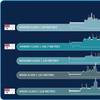RINA Report Deflects Sole Blame In Ship's Loss
The results of the RINA internal technical investigation indicate that the Erika was presumably lost because an initial crack in the low part of the hull below the water line was misjudged and mishandled, allowing it to develop until the hull broke up 18 hours later. According to RINA, the ship was not lost because of an overall hull girder collapse but because she suffered a progressive structural failure.
RINA's report, jointly prepared with Three Quays Marine Services and Studio Tecnico Navale Ansaldo, says the crack may have originated from a defect or brittle fracture in way of the bilge. "Many cases are known of ships whose structures suffered cracks, but with proper handling, the situation was kept under control," says Nicola Squassafichi, managing director of RINA. "This crack, whatever its origin, could hardly have led, in 18 hours, to the deterioration of the situation and the loss of the ship, in the absence of other contributory factors, in particular the mishandling of the ship and insufficient support from the shore."
Factors which are also deemed to have contributed to the ship loss are the loading sequence and resulting loading condition at departure, the effect of the heated cargo, the bad sea conditions during the last voyages, and the repairs carried out during her life.
"Based on the internal investigation concerning the activities carried out by RINA for classification and statutory purposes, and subject to further investigations on the origin of the crack, which might have arisen during the repair works, RINA takes the view that it has substantially complied with the applicable rules, guidelines and procedures," says Squassafichi. "It is appropriate to recall that the proper operation and maintenance of the ship is solely under the responsibility of the shipowners or the ship managers. As specified by the rules for ship classification, the concept of class implies that the ship is loaded, operated and maintained in a proper manner by competent and qualified crew and shore personnel. Shipowners or ship managers should ensure proper control, care and maintenance of the ship in the period between class surveys."
The events that led to the loss of the ship and their sequence highlighted the utmost importance of the competence and preparedness of the crew and the company in handling emergency situations. RINA is considering this issue in depth, with the view to proposing further improvements in the present requirements of the ISM Code and their implementation to the competent organizations.
RINA also calls upon the EU and all shipping organizations to campaign for the establishment of a coastal state regime, which would identify ports of refuge and publicize the fact that they are equipped and able to handle casualties. The Authorities in such ports should also be able to give proactive assistance to ships in distress, particularly in situations where the crew or owners/managers are not responding appropriately and human lives or the marine environment are at risk.
RINA is part of the Registro Italiano Navale group and is a Genoa-based classification society that was formed in 1861. It was a founding member of the International Association of Classification Societies (IACS). Today it classes 3,000 ships totaling more than 18 million gt. It has particular expertise in passenger vessels and fast craft.
RINA has consistently had good Port State Control figures and an excellent track record with respect to pollution from vessels under its class. It employs more than 645 people in 51 offices around the world and is of critical importance to the Italian shipowning and shipbuilding industries.











